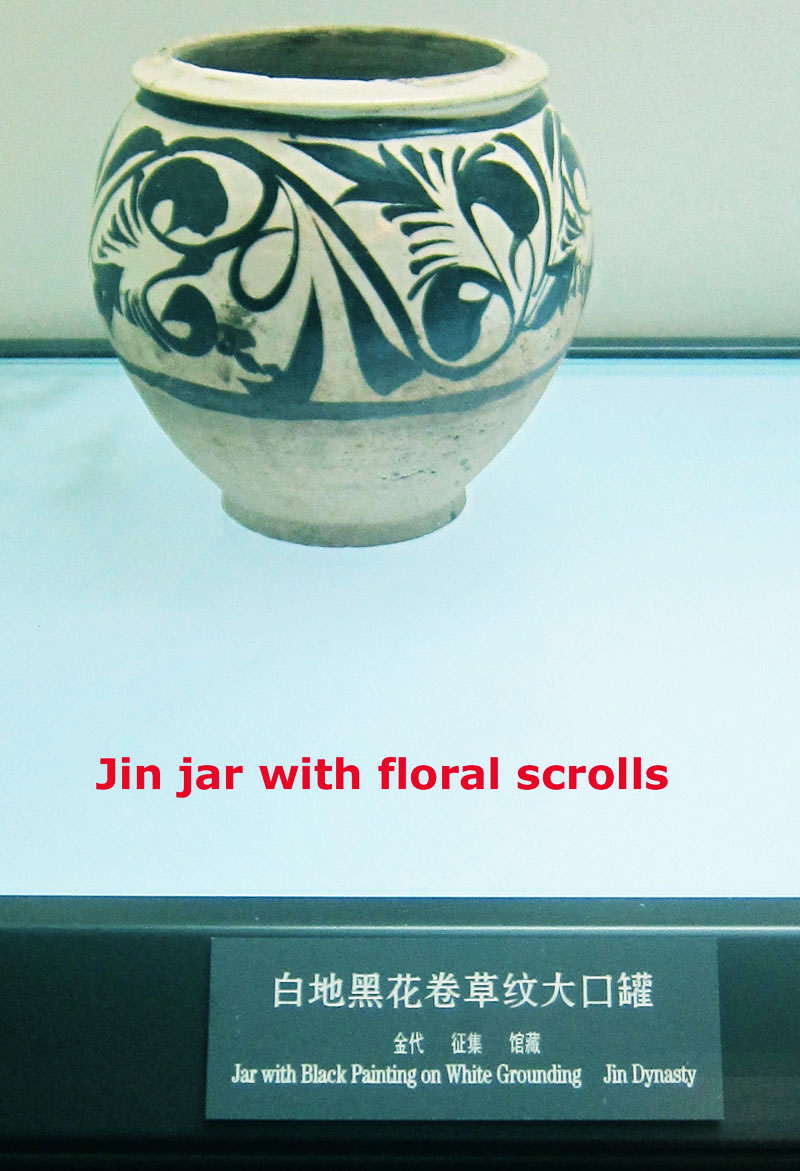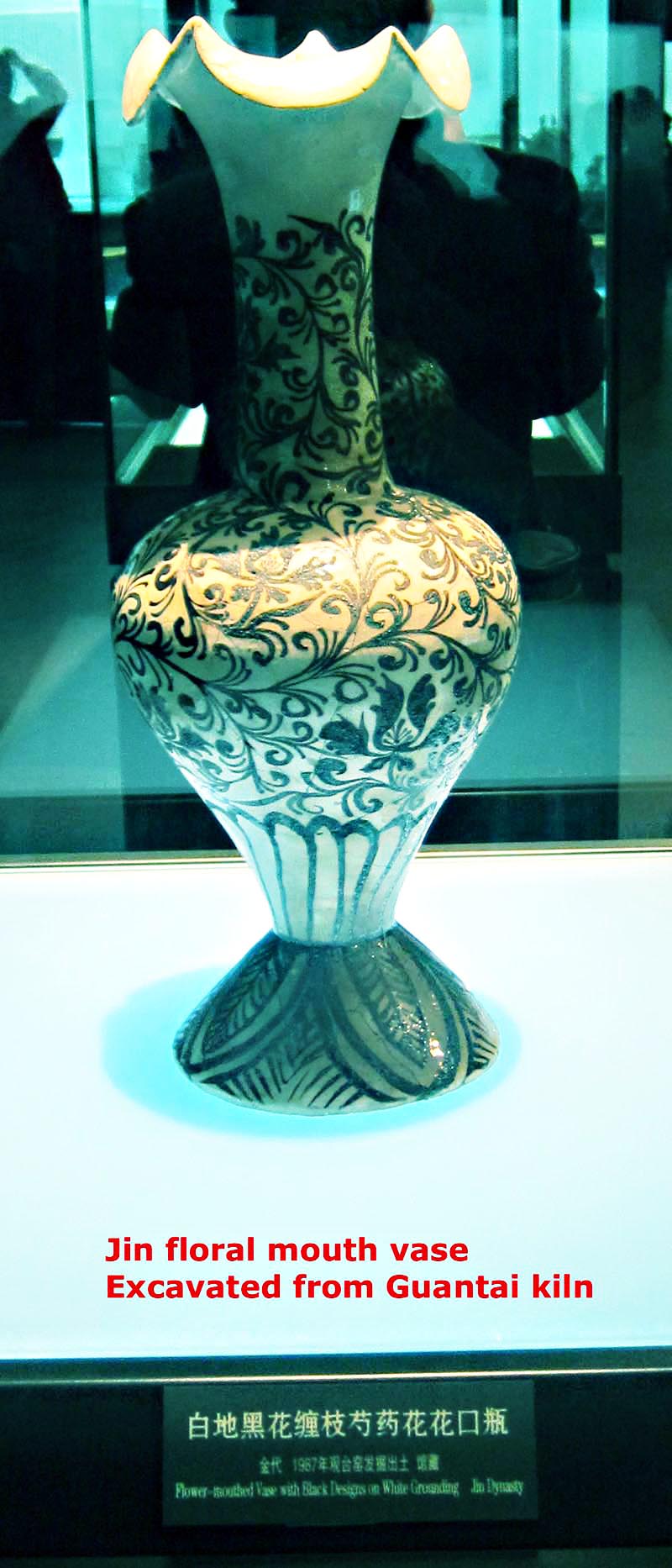Iron black/brown Painted Motif
Another outstanding contribution of the Cizhou potters was
painting of traditional Chinese art painting on the wares. During the late Northern Song period,
painted iron black/brown motif emerged. There were very few that
could be dated confidently to the Late Northern Song phase. Most were
from the Jin period during which this particular decorative technique became
the dominant form and was developed to great sophistication and maturity. The potters drew their
inspiration from Chinese ink painting. The material for the drawing was prepared
from a high iron oxide rock called Ban Huashi (班花石)in
Chinese.
Besides Hebei kilns such
as those in Guantai (观台), Dong
Aikou (东艾口), Yezi Cun (冶子村), Pengcheng
(彭城) and Linshui (临水), those in
Henan such as Xinmi (新密), Jiaxian (郏县),
Yuzhou (禹州), Lushan (鲁山),
Yiyang (宜阳), Hebi (鹤壁)
, Shanxi Jiexiu (山西介休)
and etc., also produced them. Some of the best products in this category could
be found in Yuzhou Pacun kiln (禹州扒村). It is typified by white glaze and glossy
black motif. Cizhou iron-painted motifs were much appreciated by the
common folks and served as the blue-print for painted decorations in
subsequent Yuan Blue and white.
According to Nigel Wood in
his
book Chinese glazes, the Cizhou glaze is unusually low in calcium oxide and high
in alumina. Hence, it is viscous and greatly controlled the diffusion of the
underglaze iron pigments and the motif thus retained its
sharpness.
Many
of the iron-painted drawings, especially those dated to the Northern Song/Jin
period, were of very high standard. They
were executed in strong and spontaneous strokes which exudes an energy that is
pleasing and invigorating to the viewer. In some pieces, some of the
final details of the painted motif is incised, such as the veins of the leaf
or feathers of the birds. Some of the iron-painted wares from the Jin
period were covered with lead-green glaze. Those that were covered with
torquoise glaze made its first appearance during the Yuan Dynasty.






The pillow is one
category of the vessels which one can fully appreciate the rich varieties of
iron painted subjects which the Cizhou potters were capable of depicting with
much maturity. They consisted of subjects such as frolicsome
infants, animals, birds, flowers, poetic inscription, landscape, episode taken
from plays, historical event and etc.
In terms of varieties, those from Hebei Cizhou were most varied and
interesting. Some of the pillows also carried impressed mark of the
factory such as the famous Zhang Jia zao (张家造).
Many of those with this mark orginated from Dong Aikou (东艾口)
and Yezi Cun (冶子村) kilns in
Cixian. There are also others with other surname such as Wang (王),
Li (李) , Zhao (赵)and
etc. It indicated that there were specialised
workshops that produced such items. Many of the bean shaped, hexagonal and ruyi
shaped pillows has a standard composition. The flat surface is decorated
with the main motif whereas the wall is decorated with classic
scrolls. There are also those which the walls are not decorated.





During
the Yuan Dynasty, the pillow evolved into the rectangular form
with a length of more than 40 cm. One famous
category has the Fuyuan Wang Jiazao (滏源王家造)
wordings
usually written on the back wall of the pillow. Such pillows were made in
kilns in Pengcheng which is situated near the source of the Fuyang river, ie
Fuyuan (滏源). Many of the Yuan pillow has main motif which
depicts scene from
historical event or Yuan plays. Many of those with calligraphic inscriptions were poems from
the Yuan Dynasty.




Jars constitued an
important category of consumer items and many are dated to Yuan period.
There are those large jars with a bulbous body and more elongated form with
lugs which were used mainly to store wine. The usuage is clear as stated
on the jar such as the name of the wine "Li Hua Bai" (梨花白)
or name of the wine/food establishment "Ren He Guan" (仁和馆).





Large
basin constituted another very important group of consumer items. Those
dated to Pre Yuan tends to be taller, while the made from Yuan onward
are flatter and wider. Fishes,
wild geese and lotus were some of the most popular motifs used to decorate
such items.




During the Yuan period, most of the bowls were
decorated with simple decoration such as stylised flowers or a chinese character
or a short inscription. During this period, instead of using spurs as
separator for stacking during firing, the potters changed to using sandy lumps
which left sandy patches on the interior and foot of the bowls and plates.




\
Page 2
Continue
to :
Page 3,
Return to:
Page 1, Home


























